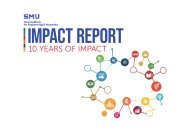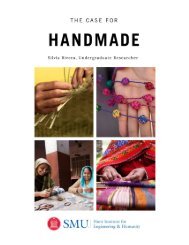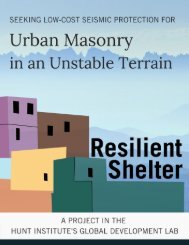Bridging the Gap in Diagnostics
Traditionally, biomedical engineers have developed technologies in response to the needs of the developed world’s medical community. These approaches often do not address the needs of the majority of the world’s peoples afflicted with both communicable and non-communicable diseases as the developments are far too costly and those with most need have, at best, limited access to supporting clinical laboratory infrastructure in developing countries. A gap in care has emerged as a result of these conditions. As a result, Drs. Beskok and Koklu have developed a Lab on a Chip technology that can test for a chosen disease with a turnaround time of just a few seconds and a detection limit of 1 ng of antigen per 1 mL of sample fluid. This is a great improvement to current devices on the market and is particularly useful in high-throughput, low-skill staffing environments. This report researched and authored by an interdisciplinary group of undergraduate students at the Southern Methodist University working in the Hunt Institute aims to address the areas of greatest need in response to UNSDG #3 "to ensure healthy lives and promote wellbeing for all at all ages."
Traditionally, biomedical engineers have developed technologies in response to the needs of the developed world’s medical community. These approaches often do not address the needs of the majority of the world’s peoples afflicted with both communicable and non-communicable diseases as the developments are far too costly and those with most need have, at best, limited access to supporting clinical laboratory infrastructure in developing countries. A gap in care has emerged as a result of these conditions. As a result, Drs. Beskok and Koklu have developed a Lab on a Chip technology that can test for a chosen disease with a turnaround time of just a few seconds and a detection limit of 1 ng of antigen per 1 mL of sample fluid. This is a great improvement to current devices on the market and is particularly useful in high-throughput, low-skill staffing environments. This report researched and authored by an interdisciplinary group of undergraduate students at the Southern Methodist University working in the Hunt Institute aims to address the areas of greatest need in response to UNSDG #3 "to ensure healthy lives and promote wellbeing for all at all ages."
Create successful ePaper yourself
Turn your PDF publications into a flip-book with our unique Google optimized e-Paper software.
4.0 PROPOSED DISEASES
The World Health Organization defines health as a state of complete physical, mental and
social well-being and not merely the absence of disease or infirmity. Human rights doctrines that
call for adequate health are also often phrased broadly, making “good” hard to quantify. In
attempts to best describe and measure health phenomena on a global scale, various health
indicators have been developed and standardized. In general, they are categorized into proximal
and distal indicators. Proximal indicators aim to provide direct measurements by looking at
diseases, deaths, and use of services. Distal indicators aim to measure social development,
education, and poverty indicators to find correlations. 3
Medical practices and forms of treatment often vary depending on access to resources.
Quality of care is generally comprised by the three sections of structure, process, and outcomes.
Structure refers to the material characteristics such as infrastructure, tools, technology. Process
refers to the interaction between caregivers and patients during which structural inputs from the
health care system are transformed into health outcomes. Lastly, outcomes can be measured in
terms of health status, deaths, or disability-adjusted life years—a measure that encompasses the
morbidity and mortality of patients or groups of patients. 18
Primarily through the practice of Epidemiology, which looks at the incidence,
distribution, and possible control of diseases across the world, medical professionals developed
mathematical techniques to measure the rates of death and disease. Certain measures quantify the
risk of occurrence of contraction and mortality where other rates more broadly measure years of
life that are spent in good or poor health. These measures help direct needs for policy reforms,
action plans and the provision of services. The most comprehensive methods that do so are
known as Disability Adjusted Life Years (DALY). 18 One DALY equates to one lost year of
healthy life. When DALY’s are added together across a population, a measurement of the gap
between the current health status and an ideal health situation where the entire population lives to
an advanced age free of disease and disability can be seen. Quantifying the burden of disease
assists doctors, nurses, public health workers, and other medical professionals as they work to
measure the performance of health on a global, regional, national, and subnational scale. Because
the highest DALY numbers result from diseases that result in the disability of children, these
diseases are often prioritized on the global health scale. 18
In creating disease selection criteria for Dr. Beskok and his team’s device, several factors
were taken into consideration. Generally, the selection criteria consists of diseases that result in a
high DALY value, are communicable, identifiable with antibody-antigen reactions, and can be
tested for using urine. Because the LoC microfluidic platforms are employed for point of care
diagnosis purposes, they have low cost, low power consumption, short analysis time, and use
minute amounts of sample volumes. Therefore, they are useful in higher stress or emergency
situations. Diseases with high rates of communicability are those which spread and replicate
rapidly. Early detection in such cases allows for earlier treatment and decreased infection rates.
Accurate detection also decreases the rate of misdiagnosis, maltreatment, and the possibility for
the development of antibiotic resistant strains. The diseases that were identified with this
criterion were Tuberculosis and Malaria. Together, these diseases accounted for 89,011,364
years of healthy life lost in 2016. 18
23














